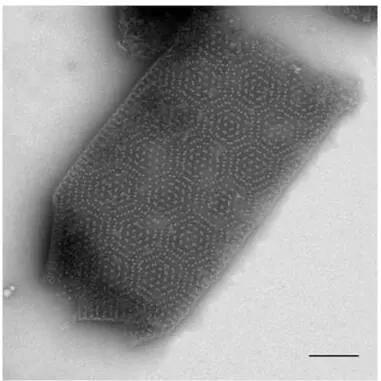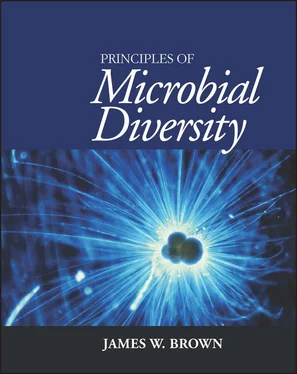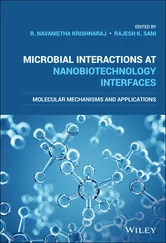We live immersed in an infinite sea of the infinitesimal. Let’s have a look.
1
What Is Microbial Diversity?
Facets of microbial diversity
What is diversity? How exactly are organisms either similar to or different from each other? This seems like an easy question in the macroscopic world, but what about microbes?
Microbes are often divided by shape into rods, cocci, and spirals. Although these are the most common cell shapes, bacterial and archaeal cells also come in a wide range of other shapes: filaments (branched or unbranched), irregular, pleomorphic (different shapes under different conditions or even in the same culture), star-shaped, stalked, and many, many others. Haloquadratum is a flat, square organism, just like a bathroom tile (Fig. 1.1).
Individual cells of whatever shape can be found in a variety of multicellular arrangements, from simple pairs and tetrads to multicellular filaments, sheets, rosettes, and true multicellular organisms. Many species form highly structured multispecies mats that resemble the tissues of animals and plants that carry out complex biochemical transformations (Fig. 1.2).

Figure 1.1The tile-shaped halophilic archaeon Haloquadratum walsbyi . (Source: Wikimedia Commons.) doi:10.1128/9781555818517.ch1.f1.1

Figure 1.2Section of a stratified microbial mat from Guerrero Negro, Baja California. (Copyright 2007, American Society for Microbiology. Photo by John R. Spear and Norman R. Pace.) doi:10.1128/9781555818517.ch1.f1.2
Most bacteria and archaea measure 1 to 5 µm, but they range from 0.1 μm in thickness to over a millimeter. At the low end, it is hard to understand how everything that is needed for life could fit into the cell. At the high end, they can be easily seen without a microscope (Fig. 1.3).
Many bacteria have “typical” gram-positive (single membrane, thick cell wall) or gram-negative (double membrane, thin cell wall) cell envelopes. However, there is wide variation even within these two major types. Many gram-positive bacteria have an outer membrane, made of mycolic acids rather than glycerol-phosphate esters. Many gram-negative bacteria lack the lipopolysaccharide layer. Many archaea and bacteria (both gram positive and gram negative) have an orderly protein coat, the S-layer (Fig. 1.4). In bacteria, cell walls are composed of peptidoglycan, but there is a surprising range of chemical variations within this type of material. Archaea do not have peptidoglycan cell walls, although some archaeal cell walls contain a related material, pseudomurein.

Figure 1.3The bacterium Epulopiscium fishelsoni (ca. 500 μm long) and four cells of the protist Paramecium (ca. 100 μm long). (Courtesy of Esther Angert.) doi:10.1128/9781555818517.ch1.f1.3
Microbes have a wide range of external structures: flagella, pili, fibrils, holdfasts, stalks, buds, capsules, sheaths, and so on. They also have a wide variety of internal structures such as spores, daughter cells, thylakoids, mesosomes, and the nucleoid. In reality, microbial cells are just as structurally organized, and diverse, as are eukaryotic cells.

Figure 1.4A negative-stain electron micrograph of the S-layer of Pyrobaculum aerophilum . Scale bar, 200 nm. (Courtesy of Reinhard Rachel.) doi:10.1128/9781555818517.ch1.f1.4
Macroscopic eukaryotes are not metabolically diverse; they are either chemoheterotrophic (e.g., animals) or photoautotrophic (e.g., plants). Bacteria and archaea have a much broader range of energy and carbon sources, which can be generally divided into four broad types, chemoheterotrophs, chemoautotrophs, photoheterotrophs, and photoautotrophs.
Chemoheterotrophs obtain both carbon and energy from organic compounds. Some organisms can use a wide range of organic compounds and can either oxidize or ferment them. Others can use only a very narrow range of organic compounds and process them in a specific way. Saprophytes and pathogenic microbes are examples of this group.
Chemoautotrophs obtain cell carbon by fixing CO 2. Energy is obtained from inorganic chemical reactions such as the oxidation or reduction of sulfur or nitrogen compounds, iron, hydrogen, etc. These organisms do not need organic compounds for either energy or cell carbon. Sulfur-oxidizing bacteria and methane-producing archaea are examples of this group.
Photoheterotrophs obtain cell carbon from organic compounds, but energy is harvested from light. Halophilic archaea and most purple photosynthetic bacteria are examples of this group.
Photoautotrophs (photosynthetic) obtain cell carbon by fixing CO 2. Energy is obtained from light. These organisms do not need organic compounds for either energy or cell carbon. Most cyanobacteria and some purple photosynthetic bacteria are examples of this group.
Microbes live in an amazing range of habitats, from laboratory distilled-water carboys, through freshwater and marine environments, to saturated brines like the Great Salt Lake or the Dead Sea. They grow at temperatures of −5°C to over 118°C; Pyrodictium cultures are sometimes incubated in autoclaves! Organisms are known to grow at pH 0 (0.5 M sulfuric acid) and at pH 11 (Drano). Very often, these extremes are combined: Acidianus grows in 0.1 M sulfuric acid at 80°C! Some bacteria live in the water droplets that make up the clouds, and others live in deep-underground aquifers or deep-sea sediments. Many microbes live in intimate symbiosis with other creatures, in complex communities, or as permanent intracellular “guests.”
In fact, if you are on or around Earth and find liquid water, there is almost certainly something living in it (Fig. 1.5).

Figure 1.5Moose Pool, Yellowstone National Park, pH ~2, 80°C. doi:10.1128/9781555818517.ch1.f1.5
It may seem odd to consider the behavior of microscopic organisms, but they do have behavior. Motility and taxis are one form of behavior, both of which come in a variety of forms, from the phototactic Chlorobium bacteria that use gas vacuoles and symbiosis with motile bacteria to adjust their place in the water column (Fig. 1.6) to the chemotactic Rhizobium bacteria that sense and swim (via flagella) toward chemical signals sent by receptive plant roots. Magnetotactic bacteria have a built-in magnetic compass that allows them to use Earth’s magnetic field for orientation.

Figure 1.6 Chlorobium symbiotic consortium. (Reprinted from Wanner G, Vogl K, Overmann J, J Bacteriol 190:3721–3730, 2008, with permission.) doi:10.1128/9781555818517.ch9.f9.10
Читать дальше


















